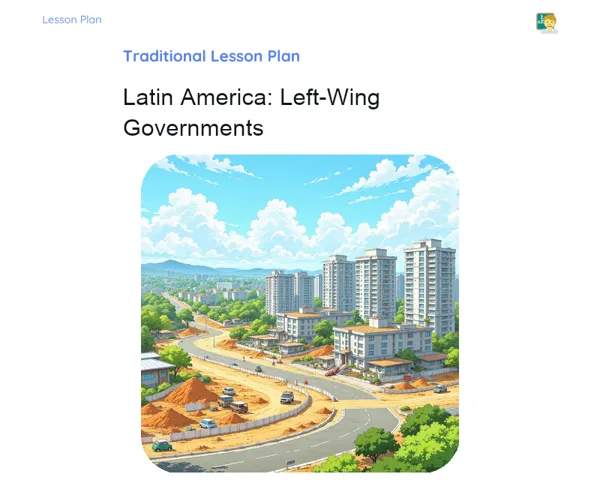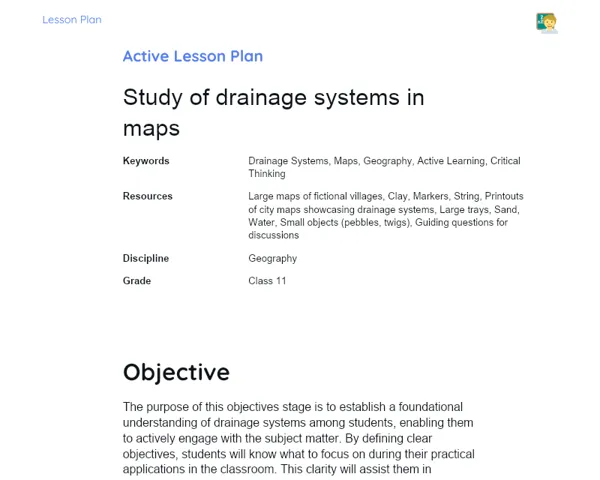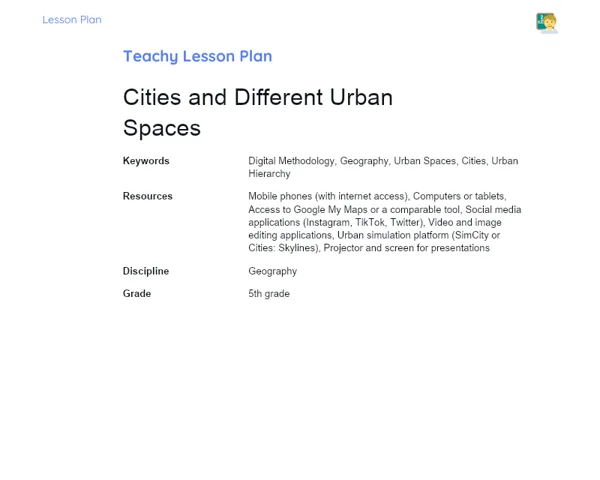Lesson Plan | Socioemotional Learning | Rural and Urban Relationship
| Keywords | Geography, Rural-Urban Relationship, Interdependence, Self-awareness, Self-control, Responsible Decision-Making, Social Skills, Social Awareness, Mindfulness, Visual Project, Empathy, Respect, Emotions, Emotional Regulation |
| Resources | Poster Boards, Glue, Scissors, Old Magazines, Markers, Colored Pencils |
| Codes | - |
| Grade | 4th grade |
| Discipline | Geography |
Objective
Duration: (10 - 15 minutes)
The aim of this segment of the Socioemotional Lesson Plan is to immerse students in the lesson's theme, helping them grasp the vital connection between rural and urban areas. This lays the groundwork for the socioemotional competencies that will unfold throughout the lesson. By appreciating the distinct characteristics and interdependence of these spaces, students will be equipped to recognize, understand, and navigate the emotions tied to various social situations, thereby fostering a stronger blend of geographical insight and socioemotional skills.
Objective Utama
1. Identify the unique characteristics of rural and urban areas, particularly focusing on food production in villages and its distribution in cities.
2. Appreciate the interconnectedness of rural and urban settings, understanding how both contribute to society's overall well-being.
Introduction
Duration: (15 - 20 minutes)
Emotional Warmup Activity
Mindfulness Moment 🌿
The chosen emotional warm-up activity is Mindfulness. This practice encourages students to focus on the present moment thoughtfully and without judgment, aiding in the development of focus, presence, and concentration.
1. Instruct students to sit comfortably, with their feet flat on the floor and hands resting on their knees or on the desk.
2. Briefly introduce the idea of Mindfulness, stressing the importance of being aware of the current moment and monitoring their sensations non-judgmentally.
3. Guide students to either close their eyes or fix their gaze on a specific point.
4. Encourage them to breathe deeply, taking in air through the nose and exhaling through the mouth in a controlled manner.
5. After a few deep breaths, prompt them to pay attention to their natural breathing and observe how air moves in and out of their bodies.
6. If any thoughts drift into their minds, gently guide them to refocus on their breath.
7. After about 3-5 minutes, invite them to slowly open their eyes and do a light stretch, extending their arms and legs.
8. Wrap up by asking how they felt during this exercise and if they noticed any change in their concentration levels.
Content Contextualization
Today's theme, Rural and Urban Relationship, is essential for understanding how rural and urban life are intertwined. For instance, the food we eat every day in our cities originates from villages. Without farmers and their produce, we would be lacking essential items like fruits, vegetables, and meats. Conversely, rural areas rely on cities for selling their products and accessing technology and various resources. Just think about how things would be if farmers couldn't sell what they grow or if urban areas lacked access to fresh food. This interdependence is what maintains our society's balance. By grasping this relationship, students can cultivate empathy and respect for different lifestyles while recognizing the vital roles both environments play to enhance community welfare.
Development
Duration: (60 - 75 minutes)
Theory Guide
Duration: (20 - 25 minutes)
1. Definition of Rural and Urban Areas: Educate students that rural areas primarily focus on agriculture, pastoral activities, and engagement with nature. Urban areas, on the other hand, are distinguished by higher population density, numerous buildings, and various economic functions including commerce and services.
2. Specificities of Rural Areas: Illustrate that life in rural settings unfolds at a slower pace, generally characterized by less pollution and traffic congestion. Here, community ties are generally stronger, as people often know their neighbors. The principal sources of livelihood are agriculture and animal husbandry. Examples include corn farming, and dairy production.
3. Specificities of Urban Areas: In urban environments, the pace of life is busier due to a larger population and more vehicles. There is a wider array of services available, like schools, hospitals, shops, and entertainment options. The economy is multifaceted, providing job opportunities in sectors such as trade, industry, and technology. Examples encompass corporate offices, clothing retail, and healthcare facilities.
4. Interdependence between Rural and Urban Areas: Clarify that rural and urban settings are mutually dependent. Rural areas supply food and raw materials for cities, while cities provide technology, market access, and services to rural settings. This synergy is key for the survival of both.
5. Examples of Interdependence: Offer relatable examples: milk from rural dairy farms is processed in cities before reaching urban supermarkets; tractors used by farmers are made in city factories; fresh produce arrives at urban markets thanks to the logistics managed by urban infrastructure.
6. Analogies for Understanding: Use the analogy of a body to convey interdependence: rural areas can be likened to the stomach that produces and processes food, while urban areas act like the brain that orchestrates and disseminates resources throughout the body (society). Both are indispensable for the healthy functioning of the whole.
Activity with Socioemotional Feedback
Duration: (35 - 45 minutes)
Rural-Urban Interdependence Project
In this collaborative task, students will create a visual representation illustrating the interdependence between rural and urban settings. They will work in teams to identify products originating in rural areas that are utilized in urban settings, and vice versa. The aim is to assemble a visual board using poster paper, drawings, magazine cut-outs, and other materials at hand.
1. Divide the students into groups of 4-5 each.
2. Distribute a poster board, glue, scissors, old magazines, markers, and colored pencils to each team.
3. Guide the groups to discuss and compile a list of products originating in rural areas that are consumed in urban environments (like milk, fruits, vegetables) along with items from cities that are used in rural settings (like tractors, fertilizers).
4. Ask them to either draw or cut out images representing these products from the magazines and stick them onto the poster board, creating their visual display.
5. The groups should map connections between rural producers and urban consumers with arrows or lines.
6. After finishing their poster, each group is to present their project, discussing the links they've illustrated.
Discussion and Group Feedback
Following the project presentations, initiate a class discussion using the RULER framework. Recognize students' emotions by inquiring how they felt throughout the activity—were they thrilled, puzzled, or inquisitive? Understand the reasons behind these emotions by exploring what prompted their feelings, such as group interactions or new insights. Label their emotions correctly to help them identify feelings like frustration, joy, or confusion. Express their feelings appropriately, fostering an environment for students to share their own experiences and to engage respectfully with their peers. Finally, Regulate emotions by discussing how to handle negative feelings and reinforcing positive ones such as teamwork and empathy. Prompt students to reflect on how the rural-urban relationship impacts their lives, whether during supermarket visits or while visiting relatives in the countryside. Encourage them to appreciate the significance of both environments and the contributions they make to society at large.
Conclusion
Duration: (15 - 20 minutes)
Reflection and Emotional Regulation
For the reflection and emotional regulation segment, encourage students to jot down a brief paragraph or engage in group discussions about the challenges they faced throughout the lesson. Prompt them to reflect on their emotional states during various activities—working in groups, presenting their thoughts, or listening to peers. Urge them to consider how they navigated their feelings, whether they experienced frustration, joy, anxiety, or contentment, and how they can effectively handle these emotions moving forward.
Objective: This part aims to foster self-reflection and emotional regulation among students. By pondering the challenges faced and emotions felt during the lesson, they can identify productive strategies to tackle similar situations in the future. This activity seeks to enhance self-awareness and self-control, empowering students to recognize their emotions and improve their capacity for emotional management.
Glimpse into the Future
To round off and focus on the future, prompt students to set personal and academic objectives based on the lesson content. These goals might involve diving deeper into the rural-urban interdependence theme, visiting a local farm or market to see the connection in real life, or honing social skills like communication and teamwork. Encourage students to write down these goals and share them with the class, promoting a collective dedication to ongoing learning.
Penetapan Objective:
1. Gain deeper insights into the interdependence between rural and urban areas.
2. Visit a nearby farm or market to observe the rural-urban dynamics firsthand.
3. Cultivate social abilities like communication and teamwork.
4. Foster empathy and respect for diverse lifestyles in both rural and urban contexts.
5. Implement the knowledge gained in future activities, like school projects or family discussions. Objective: The goal of this section is to cultivate students' independence and practical application of learning. By establishing personal and academic goals linked to the lesson content, students are encouraged to pursue their academic and personal growth proactively. This activity aspires to promote ongoing learning and integrate socioemotional skills into students' everyday lives, inspiring them to apply what they've learned in meaningful and practical situations.



